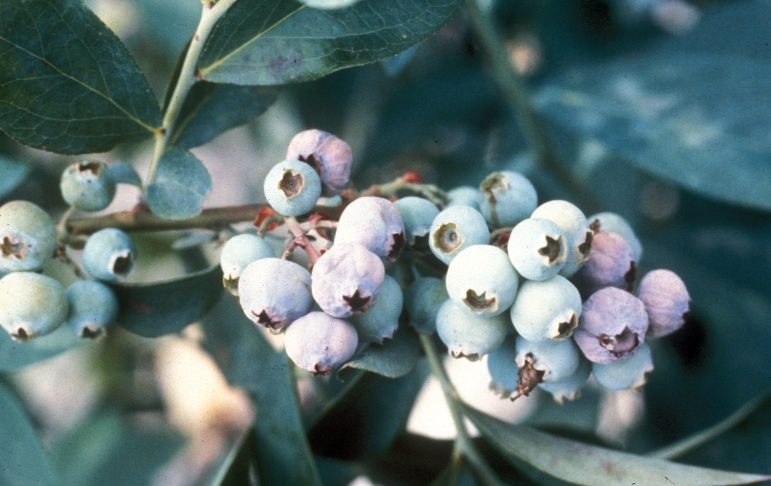Crop Production

Disease issues can be a real problem in blueberries. There are many management aspects that growers can do before, during, and after planting to reduce the risk of problems. These management aspects include the following:
- purchasing plants from a reliable source
- planting the recommended cultivars
- planting correctly on raised beds in the full sun
- controlling weeds
- mulching
- irrigating
- fertilizing
- pruning correctly
Common Diseases
Even while taking the proper management steps, diseases can still occur. There are several diseases that affect blueberry plants, with mummy berry, phytophthora root rot, and botryosphaeria stem blight being some of the most common.
Mummy Berry
Mummy berry has been a problem for years, but in recent years there have been an increasing number of calls about the disease. Growers may notice the disease when little stems near the bloom or fruit start to wilt and die. There are other blights that cause the small stems to die, but when the developing fruit starts to shrivel up and harden, mummy berry is the cause. This disease overwinters on the ground where infected berries fell from the year before.
Mummy berry is commonly spread from one farm to another with shared harvesting equipment, but it can be common in-home plantings as well. The disease likes low, wet areas, so choosing the right planting site and using raised beds is key to prevention.
This disease is spread from the previous season’s infected fruit to the plant through the blooms. Raking out or removing the infected fruit is beneficial but can be time consuming on a large scale. Adding mulch and covering the infected fruit can also help. Fungicides can be used early in the spring as well. Spraying fungicide a few times while the plant is blooming can help
Phytophthora Root Rot
Phytophthora root rot can be a serious problem in low lying areas. Years ago, it was common to plant rabbiteye plants at ground level and plant Southern highbush on mounds, as Southern highbush are extremely susceptible to phytophthora root rot.
Since this disease is so common, professionals recommend building a mound before planting any blueberry plant and stay away from low areas. The disease will attack the roots, but the first symptom will be yellowing leaves. The leaves will eventually drop from the plant and the stems will begin to die as well. Improving drainage or planting in another location may be the best way to manage the disease.
Botryosphaeria Stem Blight
Botryosphaeria stem blight can be a major problem on commercial farms as well as home plantings. Growers can find dark brown-to-black branches that will eventually girdle the stem and cause dieback. When cutting into the infected stem, growers can see brown discoloration inside the stem.
Blueberry is an easy plant to root, but do not take cuttings from infected plants. The death rate for young, infected plants is high, and planting disease free plants is extremely important. Older plants do suffer, and the growth rate is reduced, but mortality is not as bad. The disease enters the plant through wounds from mechanical harvesters or pruning. Growers should ensure that they do not spread the disease from one plant to another when pruning. It takes time, but it is important to clean your pruners as often as possible with a 10% bleach solution or by using rubbing alcohol.
This disease is not active in cold weather, so pruning diseased branches in the winter is highly recommended. This disease is stress related, so make sure the plants are planted correctly in the proper place. Also, make sure to properly irrigate, mulch, and manage weeds. Fungicides are mostly ineffective in managing this disease, but some fungicides have helped when sprayed directly after pruning.
More Information
Sometimes it is hard to tell from a description what kind of disease is present. Alabama Extension has plant pathology labs in Birmingham and Auburn where people can send samples for identification. Depending on what the lab conducts, it may cost between $15 and $30. For help with sending samples–or if you have any questions about these or any other pests associated with blueberries–contact your county’s Extension office.

